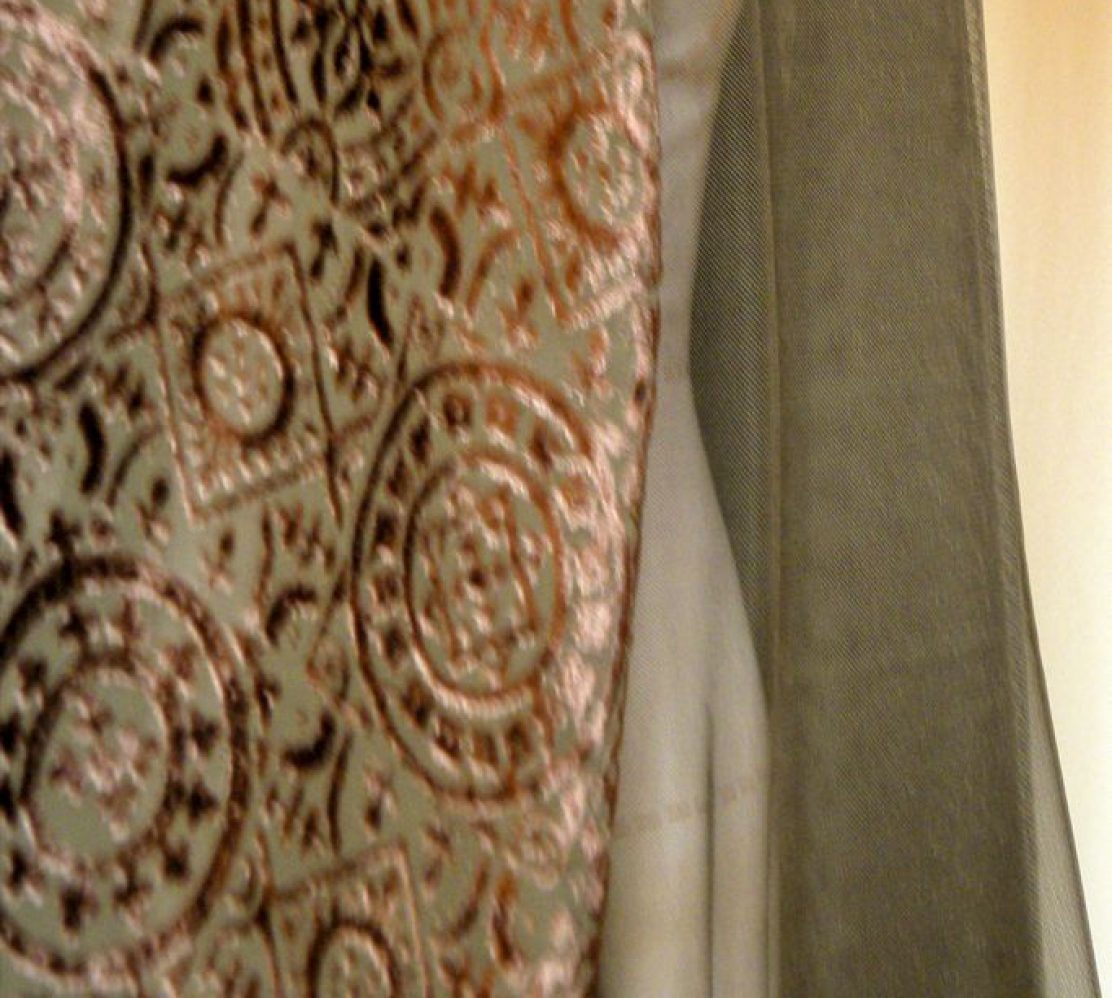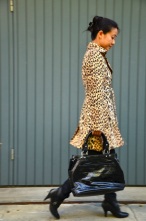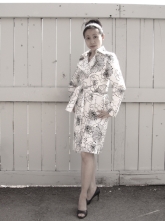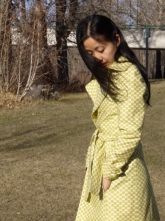So it turns out I was crazy enough to try both types of FBAs, though only in tissues. There is a limit to my patience however, so I won’t be repeating the same in muslin or fashion fabric. And I also ran out of patience to do only 1-2 change at a time. So this second round covers multiple changes.
Second alterations:
 Forward Head Adjustment Fitting & Pattern Alteration style:
Forward Head Adjustment Fitting & Pattern Alteration style:
Added 1/2″ to back shoulder at neck edge. Shifted the whole front neckline down 1/2″, so removed 1/2″ from front shoulder at neck edge & lowered CF neckline 1/2″. This is to take care of both the Shoulder seam that’s too far back at the neck edge and the neckline at CF that’s too high for a jacket.- Wide Shoulder Adjustment:
Added just over 1/4″ to shoulder, blending to original armscye at end of gather points. - Full Bust Adjustment + Low Bust Adjustment + Short-Waist Adjustment:
A) Dart-based FBA on Front Copy 1:
Added 7/8″ in width to front panel at bust level.
B) Princess FBA on Front Copy 2:
Added 7/8″ in width to side front panel at bust level.
In both instances, I didn’t follow Jackets For Real People‘s instruction exactly. The waist already is already 8″ bigger than my waist. I didn’t want to add another couple inches. So instead of keeping the spread below bust point the same all the way down, I angled it back to original width at waist level.
Also, instead of adding extra 1/2″ length that result from the FBAs to the front panel, I removed 1/2″ length from the side front, side back, & back panels instead. This is to take care of some of my Short-Waist Adjustment at the same time.
For the Princess FBA I also didn’t bother lowering the bust fullness first. I wanted the princess seam line to be closer to the bust point. By simply drawing in my bust level (about 1″ lower) it brings the princess seam 1/8″ closer to my bust point. The side front panel doesn’t have a pronounced bust curve anyway. I measured both bust levels and they’re exactly the same width on the side front panel. So lower the bust fullness seemed unnecessary. But to be clear, the point where I pivot the vertical cutline toward the armhole is on my lowered bust line. - Sway Back Adjustment:
Removed an additional 1/2″ length from CB, tapering to nothing at side seam.
Once I finished all the alterations I’ll photograph & annotate the final pattern so you can see what these alterations look like on the flat patterns.
Tissue Fitting #3:
Fixed:
- Shoulder seam now looks more balanced: Armscye side aligns with the middle of my arm joint. Neck side aligns with the back of my ear (like mentioned on p163 of Fit For Real People under “Head Sits Forward on Body” heading!).
- Neckline at CF now gives me a bit of breathing space!
- Shoulder now wide enough to reach my shoulder joint. Could probably be even wider for a jacket. But I don’t like the big shoulder look since my shoulder is already a bit wide compared to rest of my body.
- CF at bust level now reach my CF.
- CB no longer swings to the side & side seam no longer swings to the front. Waist level and hem both seem to be at the same level at CF & CB.
Adjustments still needed:
- Waistline now seem about 3/8″ too low all around. Not sure if it’s worth adjusting. Kenneth King’s Moulage CD book‘s instruction for jacket sloper shifts the waistline down by 1/2″ & out to the side by 1/2″. So maybe this 3/8″ lower waist is fine for a trench?
- Front armhole seems a bit too bigger now. On the other hand, my arm joints seem to have quite a wide range of motion. Garments I made before that have reasonable looking armhole end up feeling too tight / restrictive in the front when I reach forward & in the back when my arms are by my sides. Maybe I’ll try on the sleeve pattern before deciding what to do. My arms are also on the thin side. If I leave the armhole this wide, I might end up with sleeves that are too wide too.
- CF seems to swing out to the side. But I’m not sure if that’s normal & caused by the cleavage (valley between the Girls!). Many of the After photos in FFRP & JFRP have the same swing to the side on the front tissue pattern, but the final garment shots look fine.
- Still need to check if hip at the right level. The hip is already 6″ bigger than mine, so I think I might not need to do any width adjustments.
- Still need to check if pocket holes are at a comfortable height. I’ve already decided long ago to replace the pocket pattern with my own. Many reviewers on Pattern Reviews complained about the pockets being too small. My RTW version was also too small. I wonder if it’s something to do with the front buttons & the positioning on the princess seam rather than side seam.
Now the winner of the FBA contest is…
As you can see from the photos above, they’re six of one half-a-dozen of the other. They both look about the same.
The dart-based FBA maybe has slightly better shaping at the bust. But that’s only because the princess seam on this pattern doesn’t run through the bust point. I could maybe shift the princess seam a bit towards the front / bust point to improve the shaping in the princess FBA version.
The dart one seems to give a slimmer looking waist by comparison to the wider looking bust & the sharper angle of the princess seam above the waist. But the princess one creates a stronger vertical line, which could be slimming & make one look slightly taller. So I guess it’s down to what visual effect you’d want.
Me, I decided to take Mezzo Couture‘s suggestion and go with the princess FBA version this time. I already got a darted version in Vogue Patterns 1233 dress which I can convert into a trench. But I will cut a wider seam allowance in the side front panel. This will allow me the option to move the princess seam closer to the bust point during the fashion fabric fitting stage and see which I prefer.
















 Jackets For Real People
Jackets For Real People


















